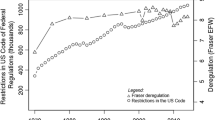Abstract
Many decisions by regulators have been analyzed over the last two decades in an effort to test regulatory behavioral theories. As a result, the interest group theory of behavior has gained a considerable following and the public interest theory has been largely dismissed. However, many of these tests are inadequate; with the regulatory decisions analyzed, both the interest group and public interest theories lead to the same predictions. To properly distinguish between these theories, a set of necessary conditions that a regulatory decision must satisfy is developed. Based on these conditions and the extant empirical literature, public interest concerns of regulators cannot be dismissed, and a more general theory of regulatory behavior is suggested.
Access this article
We’re sorry, something doesn't seem to be working properly.
Please try refreshing the page. If that doesn't work, please contact support so we can address the problem.
Similar content being viewed by others
References
Baron, David P. (1989) ‘Design of Regulatory Mechanisms and Institutions’, in R. Schmalensee and R. Willig (eds.)Handbook of Industrial Organization, 1449–1506. North-Holland, New York.
Becker, Gary (1983) ‘A Theory of Competition Among Pressure Groups for Political Influence,’Quarterly Journal of Economics,97, 371–400.
Berg, Sanford V. and Jinook Jeong (1991) ‘An Evaluation of Incentive Regulation for Electric Utilities’,Journal of Regulatory Economics,3, 45–56.
Berg, Sanford V. and John Tschirhart (1988)Natural Monopoly Regulation: Principles and Practice. Cambridge University Press, New York.
Boyes, William J. and John M. McDowell (1989) ‘The Selection of Public Utility Commissioners: A Reexamination of the Importance of Institutional Setting’,Public Choice,61, 1–13.
Buchanan, James M. and Gordon Tullock (1965)The Calculus of Consent. University of Michigan Press, Ann Arbor.
Davis, Otto and Andrew B. Whinston (1965) ‘Welfare Economics and the Theory of Second Best’,Review of Economic Studies,32, 1–16.
Hagerman, Robert and Brian Ratchford (1978) ‘Some Determinants of Allowed Rates of Return on Equity to Electric Utilities’,Bell Journal of Economics,9, 46–55.
Hazlett, Thomas W (1991) ‘The Demand to Regulate Franchise Monopoly: Evidence from CATV Rate Deregulation in California’,Economic Inquiry,24, 275–296.
Jarrell, G. (1978) ‘The Demand for State Regulation of the Electric Utility Industry’,Journal of Law and Economics,21, 269–45.
Joskow, Paul (1972) ‘The Determinants of the Allowed Rate of Return in a Formal Regulatory Hearing’,Bell Journal of Economics,3, 632–44.
Kaserman, David L., John W. Mayo and Joseph E. Flynn (1990) ‘Cross-Subsidization in Telecommunications: Beyond the Universal Service Fairy Tale’,Journal of Regulatory Economics,2, 231–50.
Kault, J. and Mark Zupan (1984) ‘Capture and Ideology in the Economic Theory of Politics’,American Economic Review,74, 279–300.
Kau, James B. and Paul H. Rubin (1979) ‘Self-Interest, Ideology and Logrolling in Congressional Voting,’Journal of Law and Economics,22, 365–84.
Nelson, D. and Eugene Silberberg (1978) ‘Ideology and Legislature Shirking’,Economic Inquiry,25, 15–25.
Nelson, R.A. (1982) ‘An Empirical Test of the Ramsey Theory and Stigler-Peltzman Theory of Public Utility Pricing’,Economic Inquiry,20, 277–90.
Noll, Roger (1989) ‘Economic Perspectives on the Politics of Regulation’, in R. Schmalensee and R. Willig (eds.)Handbook of Industrial Organization, 1253–1287. North-Holland, New York.
Nowell, Clifford, and John Tschirhart (1990) ‘The Public Utility Regulatory Policy Act and Regulatory Behavior’,Journal of Regulatory Economics,2, 21–36.
Olson, Mancur (1965)The Logic of Collective Action; Public Goods and the Theory of Groups. Cambridge Mass, Harvard University.
Oster, S. (1980) ‘An Analysis of some Causes of Interstate Differences in Consumer Regulations’,Economic Inquiry,18, 39–54.
Peltzman, Sam (1976) ‘Towards a More General Theory of Regulations’,Journal of Law and Economics,19, 211–240.
Peltzman, Sam (1975) ‘The Effects of Auto Safety Regulation’,Journal of Political Economy,83, 677–727.
Posner, Richard (1974) ‘Theories of Economic Regulation’,Journal of Political Economy,83, 677–727.
Roberts, R.B., G.S. Maddala, and G. Enholm (1978) ‘Determinants of the Requested Rate of Return and the Rate of Return Granted in a Formal Regulatory Processs’,Bell Journal of Economics,9, 611–21.
Sappington, David E.M., and Joseph E. Stiglitz (1986) ‘Information and Regulation’, in E. Bailey (ed.),Public Regulation: New Perspectives in Institutions and Policies. M.I.T. Press, Cambridge, MA.
Sherman, Roger (1989)The Regulation of Monopoly. Cambridge University Press, New York.
Stigler, George (1974) ‘Free Riders and Collective Action: An Appendix to Theories of Economic Regulation’,Bell Journal of Economics,5, 359–365.
Stigler, George (1971) ‘The Theory of Economic Regulation’,Bell Journal of Economics,2, 3–21.
Stigler, George (1972) ‘Economic Competition and Political Competition’,Public Choice,13, 91–106.
Takayama, Akir (1974)Mathematical Economics, Dryden Press, Hinsdale, IL, 2nd ed., 1985. Cambridge University Press, New York.
Wenders, John T. (1986) ‘Economic Efficiency and Income Distribution in the Electric Utility Industry’,Southern Economic Journal,52, 1056–67.
Zajac, Edward (1978)Fairness or Efficiency: An Introduction to Public Utility Pricing. Cambridge, Mass., Ballinger.
Author information
Authors and Affiliations
Rights and permissions
About this article
Cite this article
Nowell, C., Tschirhart, J. Testing theories of regulatory behavior. Rev Ind Organ 8, 653–668 (1993). https://doi.org/10.1007/BF01024290
Issue Date:
DOI: https://doi.org/10.1007/BF01024290




